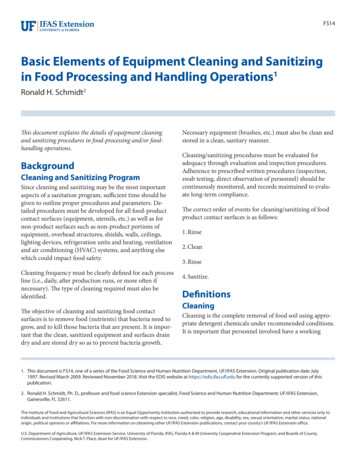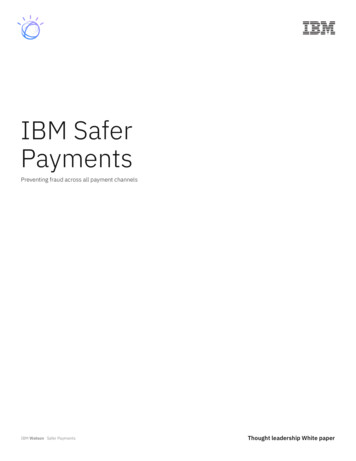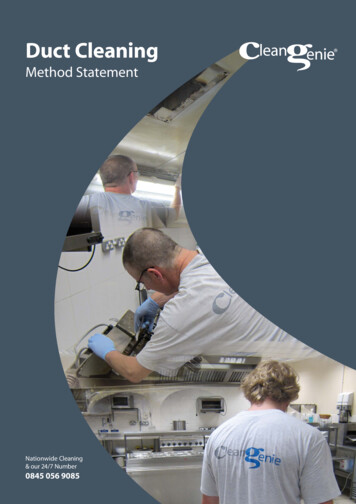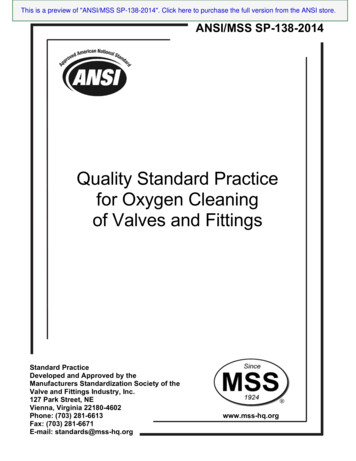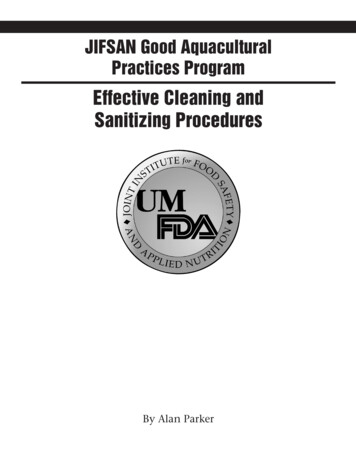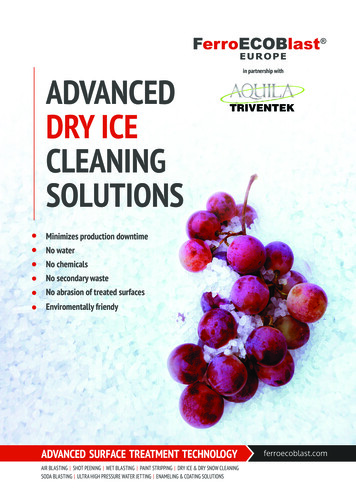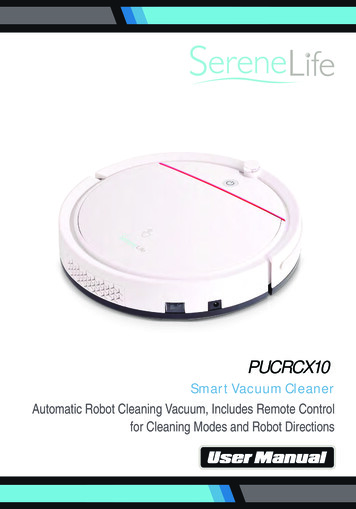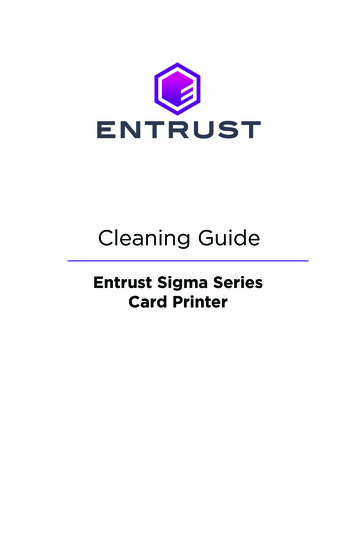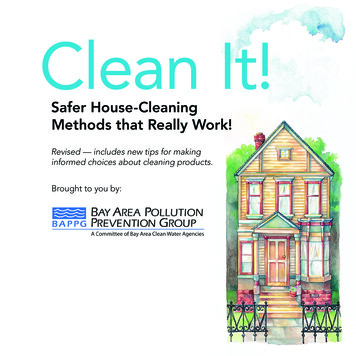
Transcription
Clean It!Safer House-CleaningMethods that Really Work!Revised — includes new tips for makinginformed choices about cleaning products.Brought to you by:
Use this Guide for a Clean Home and a Clean Bay!You don’t need harsh chemical cleaning products to clean your home.Common household products likebaking soda and white vinegar aregood all-purpose cleaners.There are very good reasons to makethe switch - some retail cleaning products can be hazardous to your healthand the health of your family and pets.The hazards can come from chemicalfumes, improper mixing of more thanone product, or from children or petsingesting the products.By buying and using fewer potentiallyhazardous products in the first place,you’ll create a safer place for you, yourfamily and pets, and the environment.For more information contact BAYWISEat 1-888-BAYWISE (229-9473), or visitwww.baywise.org.In addition, some chemicals in products disposed of down the drain mayend up in San Francisco Bay and thePacific Ocean. The resulting “chemicalsoup” can adversely affect aquaticcreatures, and contribute to the buildup of toxins in the fish we eat.2
Table of ContentsIntroduction . . . . . . . . . . . . . . . . . . 2ALL-PURPOSE CLEANERS . . . . . . 17What’s in this Guide . . . . . . . . . . . 4SCOURING CLEANERS . . . . . . . . 18Getting Started . . . . . . . . . . . . . . . 5GLASS CLEANER . . . . . . . . . . . . . 19Cleaning Tips . . . . . . . . . . . . . . . . . 6KITCHEN CLEANERS . . . . . . . . . . 20Homemade Cleaning Products . . 7OVENS . . . . . . . . . . . . . . . . . . . . . . 21Shopping List . . . . . . . . . . . . . . . . . 8DRAINS . . . . . . . . . . . . . . . . . . . . . . 22Cleaning Tools . . . . . . . . . . . . . . . . 9BATHROOMS . . . . . . . . . . . . . . . . . 23Safety Tips:Buying Retail Cleaning Products . 10TOILET BOWLS . . . . . . . . . . . . . . . 24CARPETS . . . . . . . . . . . . . . . . . . . . 25Safety Tips:Ingredients to Avoid . . . . . . . . . . . 11FLOORS . . . . . . . . . . . . . . . . . . . . . 26Resources . . . . . . . . . . . . . . . . . . . . 12FURNITURE . . . . . . . . . . . . . . . . . . 27Safety Tips:At Home and After Use . . . . . . . . . 13METAL POLISHES . . . . . . . . . . . . . 28Thanks . . . . . . . . . . . . . . . . . . . . . . 29Safe Disposal . . . . . . . . . . . . . . . . . 14Disposal Guidelines forHousehold Hazardous Waste . . . . 15Drain And GarbageCan’s And Can’ts . . . . . . . . . . . . . . 163
What’s in this GuideThis guide provides tips on safercleaning products and methods.The recommended safer methodslisted in this guide are effective.The key to easier, safer cleaning isprevention. By preventing build-upof dirt, housecleaning will be easier.Also, you can get good results withfewer chemicals if you use the righttools and techniques – and this guideshows you how. Once you’ve reducedyour reliance on specialty cleaningproducts, you can save money, too,since homemade products in thisguide cost less.Many retail cleaning products shouldnot be disposed of down drains orthrown away in the garbage. Theproper disposal methods are listedin this guide.By following the recommended safecleaning methods in this guide, youcan avoid the hazards of some cleaningproducts, and also help protect thewaters of the bay and ocean.If you feel you need to buy a cleaningproduct available from retail stores,this guide offers suggestions forselecting and using those products,but we recommend trying the safermethods first.4
Getting StartedSwitching to safer cleaning products is simple. Just incorporate the cleaningproducts and tools listed on the following pages into your regular householdcleaning methods.Here are some tips for getting started: Evaluate the cleaning productsyou already have. Use them up, ifappropriate, or follow the safe disposal methods listed in this guide. Get organized. Gather all of yoursupplies, like baking soda andwhite vinegar. Check the ShoppingList and Tools sections in this guidefor other items you may need. If there are children or pets in yourhome, set up a safe, secure storageplace for hazardous materials. Ask your school-age children tohelp you evaluate and select theleast toxic cleaning products - itmay make a good science projectfor them. Test tools, techniques, and products in a small, inconspicuous areafirst to see if results are satisfactory.5
Cleaning TipsThe more frequently you clean, theless effort it will take, because cleaningmore frequently will help preventdirt, harmful bacteria and mold frombuilding up. In addition, frequentcleaning helps keep pests such asants and roaches under control.Consider the following tips:Frequently: Wash dishes, cleankitchen sink, counters, and stovetops.Wipe showers after each use. Sweepor vacuum floors and carpets.Use the right cleaning tools and keepthem in good working order.Don’t mix cleaning products andtools - use one sponge for toilets,and another for sinks and showers.Wash rags, sponges, and brushesin the clothes washer once a week.Bacteria collect quickly in cleaningtools, so it’s very important to washthem regularly.Regularly: Wash hard surface floors.Dust furniture. Clean bathroom sink,bathtub, shower, and toilet.Occasionally: Wash windows. Cleanrefrigerator, kitchen cabinets, garbagecan, and oven.Immediately: Clean up spills - thelonger you leave the spill the morethe spill will set and stain. Use a clothor sponge to absorb spills on carpets,rugs, and furniture, then swab or wipethe spill with a damp cloth.6
Homemade Cleaning ProductsYou can make cleaning products usingbasic ingredients such as baking sodaand lemon juice, with recipes and tipsprovided in this guide. Additionalrecipes for homemade cleaningproducts can be found in variouswebsites and home product bookslisted in the Resources section.When making and using safer cleaningproducts, keep these important pointsin mind:Homemade products should belabeled to identify the ingredientsin your mixture. Never use foodand drink containers for mixtures,as this is a common cause ofaccidental poisoning.Mixtures should always be kept in achild-resistant container and out ofreach of children and pets, such as inlocked cabinets, and not where foodis stored.Avoid using dairy products, suchas mayonnaise or milk, for cleaningpurposes because they mayencourage bacterial growth andcause health risks.When using a product, test a smallinconspicuous area first to see ifresults are satisfactory.7
Shopping ListThe following are basic ingredients formaking homemade cleaners. See theCleaning Tools section for other itemsyou may wish to purchase. Now, thereare also many retail products that claimto be environmentally friendly – makesure to check the Safety Tips: BuyingRetail Cleaning Products section tochoose wisely.Store all homemade and retailcleaners out of reach of childrenand pets. Don’t store retail cleaningproducts where food is stored!Recommended Safer ProductsBaking soda with water, makes anall-purpose cleaner.Borax removes stains on toilet bowls.Lemons remove greasy fingerprints onwindows.Toothpaste cleans silver.Vegetable-based liquid soap (such ascastile soap) diluted with water makesan all-purpose cleaner.Salt can remove red wine stains.White distilled vinegar, diluted inwater, is also a good all-purposecleaner, and rinses and removesbaking soda residue.8
Cleaning ToolsWhite nylon scrubber sponge as anabrasive tool for scrubbing surfaces. Ifit doesn’t work, use a more abrasivetool, such as very fine steel wool. It’simportant to not scratch the surface,so always use tools with liquid, begentle, and test for scratching.Old 100% cotton clothing, diapers, ortowels for dusting and cleaning; or trya microfiber cleaning clothToothbrush for cleaning small crevicesSpray bottles (small and large) formixing and spraying your homemadecleanersSqueegee with replaceable bladesfor drying mirrors, glass doors, andwindowsVery fine steel wool for scrubbingmore resistant dirtPumice bar for cleaning toilet bowlstainsSponge mop with attached scrub pad“Handyman’s” apron or plastic bin tocarry your tools and products aroundwith youSingle-edge razor blade or paintscraperScrub brush (large) with stiff bristlesfor cleaning tile groutRubber gloves to protect your handsGoggles to cover your eyesPlunger and snake for clogged drains9
Safety Tips: Buying Retail Cleaning ProductsWe encourage you to use the safermethods listed in this guide. If youalready have potentially hazardouscleaning products on hand, or if youfeel you must buy them for a specificpurpose, follow these safety tips:Read the LabelLook for these words:Caution, Warning, Danger or Poison.These words are placed on productlabels to alert consumers to acutetoxicity of the products, Caution beingthe least toxic and Danger being themost toxic. However, these signalwords pertain only to the immediate(acute) hazard of the product. In mostinstances, labels do not provide information about the long-term (chronic)hazards to humans or the environment,such as whether a product contains achemical suspected of causing birthdefects, kidney or liver damage, cancer, or lung disease.Avoid products with labels that saythings like: Harmful or fatal if swallowed Use only in a well-ventilated area Flammable or combustible Do not use near heat or flame Do not smoke while using Causes severe burns on contact Can burn eyes or skinBuy only the amount you need, insteadof the larger, economical size. This willminimize the potential for spills as wellas the potential for excess productsthat go unused and may be disposedof in an improper manner.10
Safety Tips: Ingredients to AvoidSome ingredients have more risk of harming you or the environment than others and shouldbe avoided. If you decide to use a retail product, read the labels and try to choose productsthat don’t have the harmful chemicals shown here in this table. If that’s not possible, thenuse extreme care - wear gloves and goggles, have a good supply of fresh air, and keepchildren and pets safely away.Ingredients toAvoidHazardsFound InAlternativesNMP (n-methylpyrrolidone)Carcinogen,reproductive harm,central nervoussystem, skinabsorbing (liver,kidney)Carpetcleaners,upholsterycleaners, metalcleanersSee the Carpets andthe Metal Polishessections.Corrosive-causesblindnessOven cleaner,drain openerSee the Ovens andDrains sections.Corrosive-causesblindnessToilet bowlcleanerSee the Toilet Bowlssection.Skin-absorbingpoison (liver,blood, kidneys)Generalpurpose, glass,and floorcleanersSee the All-PurposeCleaners, ScouringCleaners, and tassium hydroxideSodium hydroxideHydrochloric acidPhosphoric acidGlycol ethers, such asbutoxyethanol11
ResourcesCheck the following websites and books for homemade cleaning remedies, and for additionalinformation about the safety of retail cleaning products and the ingredients they contain:HomemadeCleaningProductsClean and Green, Annie Berthold-Bond, 1994. Ceres Press.Clean House, Clean Planet, Karen Logan, 1997. Simon andSchuster Pocket Books.The Environmentally Sound Guide to Cleaning Your Home,Linda Mason Hunter, 2005. Melcher Media.HomemadeCleaners ANDChemicalSafetyThe Safe Shopper’s Bible, David Steinman and Samuel Epstein,MD, 1995. Macmillan.ChemicalSafetyThe Green Guide – www.thegreenguide.comHealth & Env. Resource Ctr. – www.herc.org/maketheconnectionJanitorial Pollution Prevention Project – www.westp2net.orgCleaning and Maintenance Management – www.cmmonline.comDesign for the Environment – www.epa.gov/dfe/Green Seal- www.greenseal.orgWashington Toxics Coalitions – www.watoxics.orgCity and County of San Francisco – www.SFApproved.orgMaterial Safety Data Sheets resource: www.ilpi.com/msdsEnvironmental Working Group – www.ewg.org12
Safety Tips: At Home and After UseWhen using any cleaning product, besensible about protecting yourself fromharmful effects of chemicals. Even the“safer” products discussed in this guidecan irritate your skin and burn your eyesif you’re not careful.At HomeRequest the Material Safety Data Sheet(MSDS) by calling the (800) customerservice number on the label, or checkthe internet for MSDS information.www.ilpi.com/msdsUse only the prescribed amount - moreis not always better.Use products in well-ventilated areas.Breathing too much of products such aschlorine, drain cleaner, oven cleaner, orsolvents can irritate the skin, lungs, eyes,and/or cause dizziness.Keep children and pets away from whereyou are cleaning to avoid distraction.Don’t clean and cook at the same time toavoid contamination.Wear protective clothing, gloves andgoggles. When finished, remove protective clothing and wash separately fromregular clothing.Use extreme care when using toxicor caustic products. Follow the safetyprecautions printed on the label withoutexception, particularly with respect to theuse of protective clothing, gloves, andgoggles and maintaining good ventilation.Never mix products containing chlorinebleach with those containing ammoniaor acid. These mixtures create a lethalpoisonous gas.After UseKeep lid tightly closed. If a child-resistantlid is provided, use it.Keep products in original container so youknow what they are.Store products out of reach of childrenand pets, such as in a locked cabinet, andnot where food is stored.Dispose of chemicals at your localHousehold Hazardous Waste Facility.Even though the label may instruct youto dispose of the product in the trash,California has strict rules about what maygo in the trash. See the Safe Disposal andthe Drain and Garbage Can’s and Can’tssections for more information.Never dump chemicals down storm drainsor catch basins.13
Safe DisposalDespite what some product labels say,many household products, includingpaints, motor oil, garden products, andcertain cleaning products, should not bedisposed of down sinks, in toilets, floordrains, or in the garbage. Some householdproducts contain toxic pollutants which,when disposed of in indoor drains, passthrough wastewater treatment plants andend up in San Francisco Bay and the PacificOcean, harming fish, aquatic species andwildlife. Throwing away household products in the garbage can harm garbagecollectors, and, once in the landfill, mayeventually contaminate groundwater, theatmosphere, and/or poison wildlife.We encourage you to dispose of yourhousehold hazardous waste safelyand conveniently through your localHousehold Hazardous Waste Facility.Disposing of chemical products at theHousehold Hazardous Waste Facilityhelps prevent water pollution. Seewww.baywise.org for additional waterpollution prevention information.Alameda County. . . . . . . . . . . . . . . . . . . . . . . . (800) 606-6066 www.household-hazwaste.orgContra Costa CountyCentral County . . . . . . . . . . . . . . . . . . . . . . (800) 646-1431 www.centralsan.orgEast County. . . . . . . . . . . . . . . . . . . . . . . . . (925) 756-1900 www.ddsd.orgWest County . . . . . . . . . . . . . . . . . . . . . . . . (888) 412-9277 www.recyclemore.comMarin County. . . . . . . . . . . . . . . . . . . . . . . . . . . (415) 485-6806 www.marinsanitary.comNovato residents only. . . . . . . . . . . . . . . . . (415) 892-7344 www.unicycler.comNapa County. . . . . . . . . . . . . . . . . . . . . . . . . . . (800) 984-9661 www.naparecycling.comSan Francisco City and County . . . . . . . . . . . . (415) 330-1425 www.sfrd.comSan Mateo County. . . . . . . . . . . . . . . . . . . . . . . (650) 363-4718 www.recycleworks.orgSanta Clara County. . . . . . . . . . . . . . . . . . . . . . (408) 299-7300 www.sccgov.orgPalo Alto residents only . . . . . . . . . . . . . . . (650) 496-6980 www.cityofpaloalto.orgSolano County. . . . . . . . . . . . . . . . . . . . . . . . . . (707) 421-6765 www.co.solano.ca.usSonoma County. . . . . . . . . . . . . . . . . . . . . . . . . (707) 565-3375 www.recyclenow.org14
Disposal Guidelines forHousehold Hazardous WasteFollow these important guidelineswhen using the Household HazardousWaste services:For guidance about what to bringto the Household Hazardous WasteFacility see the Drain and GarbageCan’s and Can’ts section.Do not transport more than 5 gallonsor 50 pounds of hazardous wastein your vehicle. State law prohibitstransportation of larger amountswithout a license.Do not mix products.Keep all chemicals in their originalcontainer. If the original container isnot available, then label the containerwith its ingredients.Make sure lids are sealed tightly.Prevent leakage. Pack containers inplastic or newspapers and put theminto a larger container that can holdthe product if a leak occurs.These items cannot be accepted atthe local facilities: radioactive materials(such as smoke alarms), explosives,reactive, and pressurized gas cylindersover 20 pounds.Business owners with hazardouswaste may call the telephone numberslisted in the Safe Disposal sectionand ask for information on Very SmallQuantity Generator (VSQG) disposal.15
Drain and Garbage Can’s and Can’tsWhen in doubt about how to disposeof a product, call your local HouseholdHazardous Waste Collection Facility.What Can Go Down the DrainHomemade cleaning products are safeto dispose down the drain withoutrisk of chemical, physical, or biologicalharm to plumbing and wastewatertreatment processes.What Can Go in the GarbageAny empty and dry container (5 gallonsor less in capacity) that has no continuous flow of liquid is safe to dispose inthe garbage.What Can’t Go Down the Drainor in the GarbageThe following should not be disposeddown the drain or put in the trash.Containers of unwanted productsshould be taken to the HouseholdHazardous Waste Collection Facility:Cleaning products (e.g., productswith words like “toxic”, “corrosive”,“flammable”, or “ignitable” mentionedon the label)Automotive products (e.g., motor oil,antifreeze, brake fluids)Garden supplies (e.g., pesticides,herbicides, fungicides)Paints and solvents (e.g., latex andoil-based paints, thinners, strippers) Do not clean oil-based paintbrushesin the sinkArt and hobby supplies (e.g., glues,photographic chemicals, paints)Medical waste, expired or unwantedmedications, and hypodermic needles16
ALL-PURPOSE CLEANERSAll-purpose cleaners can be used forcounters, cabinets, stovetops, and othergeneral areas. You can make cleanerson your own, or purchase safe retailcleaners. Always test homemade andretail cleaners on a small, hidden areato make sure it cleans to your satisfaction and doesn’t scratch the surface.Sprinkle baking soda or mix baking sodawith water and scrub with a wet sponge.If the baking soda leaves a residue, rinsewith cold water and dilute vinegar. Drywith a cloth.For stains on counters, squeeze freshlemon juice, let sit for 45 minutes,sprinkle baking soda, and rub withsponge or soft cloth.Look for retail all-purpose cleaningproducts that are not hazardous.For example, use products withd-limonene (caution if you are allergicto citrus), amine oxide or methyl soyate- use with care (keep out of your eyes wear goggles).PreventionSafer MethodsAdd 1/4 to 1 teaspoon of vegetablebased dishwashing soap or otherliquid soap (such as castile soap) to8 ounces of water in a spray bottle.Spray on surfaces and wipe clean witha wet sponge or cloth. Wipe dry.Clean up spills immediately.Clean counters and stovetops daily.Be careful using abrasive cleansers onany surface – especially plastic, glass,porcelain, wood, painted surfaces, orstainless steel – they may scratch thesurface and/or remove the finish.Make a solution of 9 parts warm waterto 1 part white vinegar. Wipe withsponge or soft cloth. Make a strongersolution for tougher jobs.17
SCOURING CLEANERSSome retail scouring cleansers containsilica or chlorine bleach. Silica can bedangerous if inhaled. Mixing cleanserscontaining chlorine bleach with otherproducts containing acids or ammoniacan create a poisonous gas. You canmake effective scouring cleansersyourself or purchase retail productswithout silica or chlorine.Safer MethodsSprinkle baking soda or make a pastewith baking soda and a small amountof liquid soap. Scrub with a dampwhite nylon scrubbing pad, soft cloth,sponge, or very fine steel wool. Testbefore using to make sure you don’tscratch the surface. Rinse with vinegarif necessary. Dry with a cloth.Retail scouring cleansers are availablethat do not contain silica or chlorine.PreventionCleaning regularly helps to preventbuild-up of grime.Be careful using abrasive cleansers onany surface - especially plastic, glass,or porcelain, wood, painted surfaces,or stainless steel - they may scratchthe surface and/or remove the finish.18
GLASS CLEANERGlass cleaners range from milddetergents to heavy-duty productswith strong solvents. Some retailproducts are mists or aerosols,which are unhealthy to breathe. Foraerosols, you end up paying extrajust for the propellants. Water ordilute white vinegar is just aseffective, if not better, than mostretail glass cleaners on the market.Safer MethodsTo remove greasy fingerprints, put1-tablespoon reconstituted (or strainedfresh) lemon juice with warm water in aquart spray bottle.For routine window cleaning, applywater with a soft cloth, squeegee dry,and rub with newspaper for a streakfree window (wear gloves to preventink from blackening hands).Try products containing amine oxide,mild detergents, white vinegar, orsimilar lower toxicity ingredients.(Keep out of your eyes - wear goggles).If the windows are really dirty, mix¼ cup white vinegar with water in aquart spray bottle. Use a white nylonscrubbing pad for stubborn dirt.Finish by rubbing with newspaper fora streak-free window (wear gloves toprevent ink from blackening hands).Streaking is often a sign that thewindow cleaning product is too strong.Try adding a little water.PreventionDo not clean windows in direct sunlight as this can also cause streaks.Did you know that there are glass window products that repel dirt? Searchthe web for ‘self-cleaning glass’.19
KITCHEN CLEANERSYou can do most kitchen cleaningwith homemade glass and allpurpose cleaner. To remove stubborncountertop rings or spots, use a mildscouring cleanser.To disinfect, usually soap and hot waterwill do the trick. To kill mold or fungus,use ¼ cup white vinegar in 1 gallon ofcold water.To remove stubborn countertop ringsor spots, sprinkle baking soda or makea paste with baking soda and a smallamount of liquid soap. Scrub with adamp white nylon scrubbing pad, softcloth, sponge, or very fine steel wool.Test before using this method to makesure you don’t scratch the surface.Rinse with white vinegar if necessary.Dry with a cloth.PreventionSafer MethodsHomemade glass cleaner or generalpurpose cleaner works well onchrome, porcelain, stainless steel,and other kitchen surfaces. Seethe Glass Cleaner and All-PurposeCleaners sections.Cleaning regularly prevents grimebuild-up.Install a plastic or glass backsplasharound your stove and food preparation counters.Use liquid kitchen cleaners containing amine oxide, mild detergents, ormethyl soyate.20
OVENSMost retail oven cleaners containsodium hydroxide, or lye, one ofthe most dangerous substances forhousehold use. Sodium hydroxidemists can blind you, burn your noseand mouth, and damage your lungs.Safer MethodsFor lightly soiled ovens, make athick paste with water and bakingsoda. Scrub well with a white nylonscrubbing pad. If the oven is greasy,add a small amount of liquid soap.To remove spots, use very fine steelwool or a plastic scraper. Rubbinggently with a wet cleaning pumice barwill remove the toughest spots andwill not scratch the surface. Retailoven cleaners are available that arenon-caustic and do not contain lye.Avoid products with the word“Danger” on the label.PreventionPreventing spills is the easiest and safest way to keep your oven clean - catchdrips by placing aluminum foil or ametal tray underneath.Spills are easier to clean up if they areattacked before getting baked on.Clean the oven regularly.21
DRAINSPrevention is the key to keeping drainsfrom becoming plugged. It is easierand more sensible than waiting fora crisis, and much safer than usingchemical drain openers.Safer MethodsFor clogged drains, use a plunger orsnake. Before using a plunger, be surethere is water standing over the drain.To get an airtight fit, apply petroleumjelly on rim. Push and pull vigorously.When using a snake, first remove allstrainers or cross bars. Gently rotatesnake and when resistance is felt,withdraw material carefully.For roots in pipes, contact a plumber orroot removal specialist to mechanicallyremove the roots. Be sure to tell serviceproviders that you want mechanicalremoval, not chemical removal.PreventionPut a strainer or filter in all drains.Never pour any type of grease downyour drains because it can can hardenand clog your pipes.After cooking, pour any grease or oildirectly into a can or jar and: For grease that is a liquid at roomtemperature (such as vegetable oilfrom a fryer), see www.baywise.orgfor local disposal drop-off sites. For grease that solidifies atroom temperature (such as bacongrease), toss the container in yourgarbage can.Avoid using the garbage disposal.Food scraps often contain grease,which can harden and clog theplumbing after passing through thegarbage disposal.Once a week, put a handful of bakingsoda down the drain followed byboiling water.Woody vegetation should be plantedScrape or wipe grease and food scraps away from sewer lines to preventblockages from roots.from dishes into the garbage or compost bin (or kitchen scrap recycling binwhere available) before washing dishes.22
BATHROOMSBathroom cleaners are designedespecially to deal with soap scum andmildew on tubs, tiles, and showers.Many retail bathroom cleaners arealso disinfectants, which temporarilykill germs on surfaces. Use the mildestproduct that meets your standards.To remove rust stains on porcelain ortile rub gently with pumice stone.To clean mold from surfaces, use amixture of 1-teaspoon of borax in aquart of hot water in a spray bottle.Wipe with a damp cloth or sponge.To remove soap scum from glass showerdoors, rub surfaces with Borax or diluted liquid soap and baking soda, andscrub with a white nylon scrubbing pad.For serious soap scum, use very finesteel wool. Rinse with cold water and,if necessary, add white vinegar to rinse.To disinfect, spray or wipe withwhite vinegar.PreventionSafer MethodsTo clean the sink, shower, tub, and tilegrout, soak the area with diluted liquidsoap, then sprinkle with baking sodaand scrub with a white nylon scrubbingpad and rinse. Use a stiff toothbrush orscrub brush for tiles. Rinse any residuewith dilute white vinegar and cold water.Bacteria, mildew, and mold generallycannot live without dampness, so keepsurfaces dry by frequent wiping (use asqueegee in the shower) and keepingthe bathroom well-ventilated.Clean the bathroom frequently.23
TOILET BOWLSYou may not need a special cleanerjust for the toilet. Baking soda or anon-chlorine scouring powder shoulddo the job. Toilet bowls generally don’tstay germ-free for long no matter whatyou use.Safer MethodsPreventionClean the toilet frequently, perhapsweekly or more. Even if you purchasecleaners, the bowl won’t stay germfree for long. Frequent, thoroughcleaning is the key no matter whatcleaner you use.To clean, scrub with baking sodaand/or liquid soap, or non-chlorinescouring powder.To remove stains, pour 1/4 cup ofborax into bowl and let sit for at least30 minutes or overnight. Scrub bowlwell and then flush.To remove mineral deposits, scrubwith bar of cleaning pumice. (Test forscratching before cleaning.)To clean exterior toilet area, spray withliquid soap diluted in water. Checkunder toilet tank and all crevices.Dry with a cloth. For heavy dirt, seeScouring Cleansers.To disinfect an area, put white vinegarin a spray bottle. Apply and wipe clean.24
CARPETSCarpets need step-wise cleaning:frequent vacuuming, spot cleaning forspills, and occasional steam cleaningfor removing deeper soil and dust. Thisapproach is good for upholstery, too.Avoid commercial spot removerswith perchloroethylene.Safer MethodsVacuuming - Dirt accumulates justinside doorways, next to furnace coldair returns, and in closed rooms. Spendextra time vacuuming these areas.Spills - Wipe up quickly before the stainbecomes permanent. Use a dry rag orpaper towel to soak up the spill. Thenext step depends on what was spilled:Using water on a rag may remove therest of the stain. Avoid warm or hotwater, as these may set the stain.edged tool, and blot liquids with adry cloth. Mix a teaspoon of milddetergent in a cup of water and thensponge the area with this mixture.Blot again with a clean, dry cloth. Toremove odors, spray with a 1:3 partswhite vinegar to water solution, andthen blot again.To remove room odors, sprinkle bakingsoda on the carpet, let stand for a fewminutes then vacuum.Steam Cleaning - There are now manyenvironmentally-friendly commercialcleaning services. Ask what solventsTackle oil or grease with your generalor chemicals the company uses beforepurpose cleaner; sprinkle baking sodahiring the service provider. Make sureon any greasy residue to help absorb it, to avoid service providers that usewait 10 minutes and then vacuum.percloroethylene.Cover red wine spill completely withsalt to soak up the wine, then blotwith a towel soaked in cold water andrepeat as needed.For tough stains, pet waste andketchup, remove any solids with bluntPreventionPrevent dirt from being tracked intothe house by placing mats in doorways.Vacuum frequently.25
FLOORSFloor care products include dustmop sprays, liquid cleaners, andfinish restorers. Many retail productscontain chemicals that have significanthealth and environmental impacts.You can look for safer products, ormake your own.Safer MethodsMop vinyl or real linoleum with adiluted white vinegar solution. Use astronger solution for tougher jobs.To cut grease on vinyl floors, dilute asmall amount of liquid soap with water.Mop then rinse with a diluted whitevi
making homemade cleaners. See the Cleaning Tools section for other items you may wish to purchase. Now, there are also many retail products that claim to be environmentally friendly - make sure to check the Safety Tips: Buying Retail Cleaning Products section to choose wisely. Store all homemade and retail cleaners out of reach of children .
